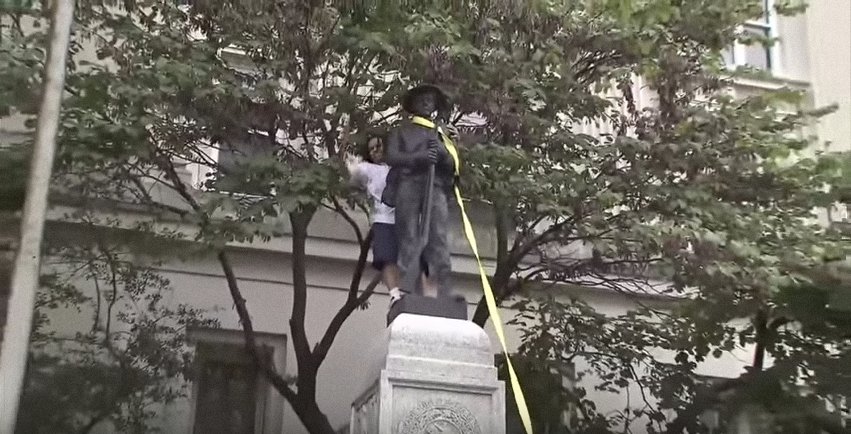Watch Protesters Pull Down a Confederate Monument in North Carolina

In only a few seconds, the 93-year-old statue celebrating the Confederacy came toppling down.
On Monday night, a crowd of anti-racist protesters worked together to pull down the monument, which was positioned in front of Durham, North Carolina’s old county courthouse. CBS North Carolina described the statue as depicting a Confederate soldier, and engraved on the front, “The Confederate States of America.” Keep in mind that for decades, people walking into the ostensible halls of justice had to pass a looming and laudatory reminder of the Confederacy.
There was considerable anger about the existence and placement of Durham’s statue, and that anger boiled over Monday: Confederate monuments have become a flash point, particularly this year, for America’s increasingly bloody culture wars. The chaos in Charlottesville was initially sparked by the white supremacists’ insistence on “defending” the proposed removal of a statue of Confederate General Robert E. Lee, whom they view as a hero.
Lee was a particularly brutal slave owner who led a Southern secessionist army dedicated to preserving slavery—an army that would enslave free blacks when they were captured. The years of tipping one’s hat to Lee’s military genius, or the myriad revisionist myths about Lee the gentleman, are over, and rightfully so. And after Charlottesville, many people are simply unwilling to wait for their officials to decide whether to remove the Confederate statues or not. They’ve stood by while the statues stood over them long enough.
It’s worth pointing out that the great majority of the monuments under debate were not erected in the immediate aftermath of the Civil War in 1865 or even shortly thereafter. They were added in highly divisive and segregated eras like the 1910s and 1920s as an explicit and pointed celebration of the war the South fought to maintain slavery.
While many pro-statue people these days like to say they are simply trying to keep their heritage and history, it’s worth looking at exactly what that history meant and the message it sends to have these Confederate men standing so proudly and prominently in Southern towns. As Reuters notes, “opponents of Confederate memorials view them as an affront to African-Americans and ideals of racial diversity and equality.” And the Southern Poverty Law Center has released a chart showing that Confederate monuments were created and schools and buildings renamed most often during times of civil rights upheaval.
The monument Durham folks toppled last night was erected 59 years after the Civil War. It’s like neo-Nazis building a Hitler statue in 2004.
— Jacob Remes (@jacremes) August 15, 2017
I personally believe that the Confederate statues have no place on prominent display in any American city. I don’t think they should be melted down to destroyed, either. I think they should all be removed post-haste and clustered into some distant and dusty field where you can wander amongst them like a grotesque graveyard to the past we’re glad to leave behind. Take a selfie with your friends while climbing to sit on top of Robert E. Lee’s head. Go wild.
Many countries have dealt with their discarded political statuary in such an isolating fashion, and it’s effective. By turning each memorial removal into a long and drawn out battle we invite more violence, and when crowds take matters into their own hands as in North Carolina, they risk criminal charges for vandalism. The statues will continue to provoke anger on both sides until they are quickly and efficiently removed.
Then those that revere them can go on however many pilgrimages they like to Far From Civilization Statue Park, and the rest of us never have to look at the paeans to the Confederacy again.
(via CBS North Carolina, Mediaite, Reuters, image: screengrab)
Want more stories like this? Become a subscriber and support the site!
—The Mary Sue has a strict comment policy that forbids, but is not limited to, personal insults toward anyone, hate speech, and trolling.—
Have a tip we should know? [email protected]
